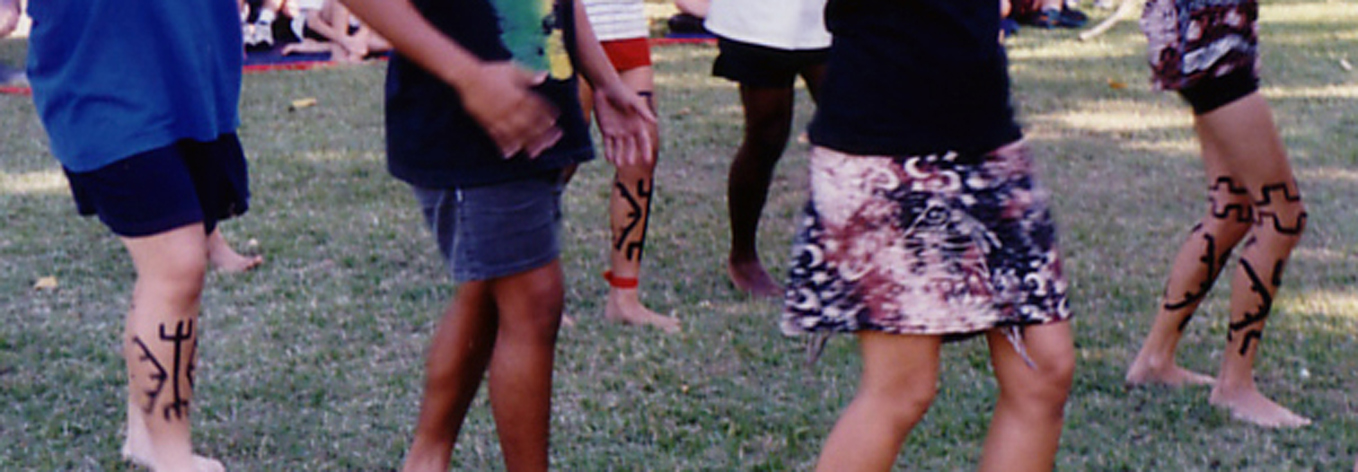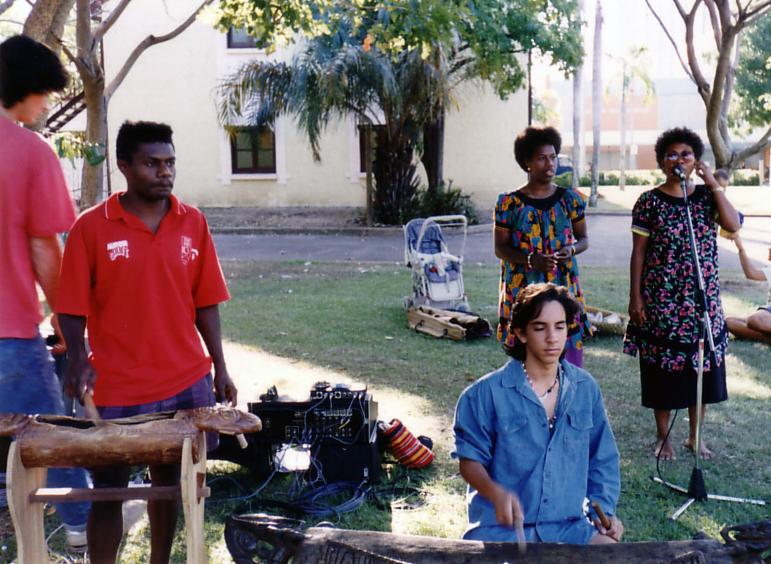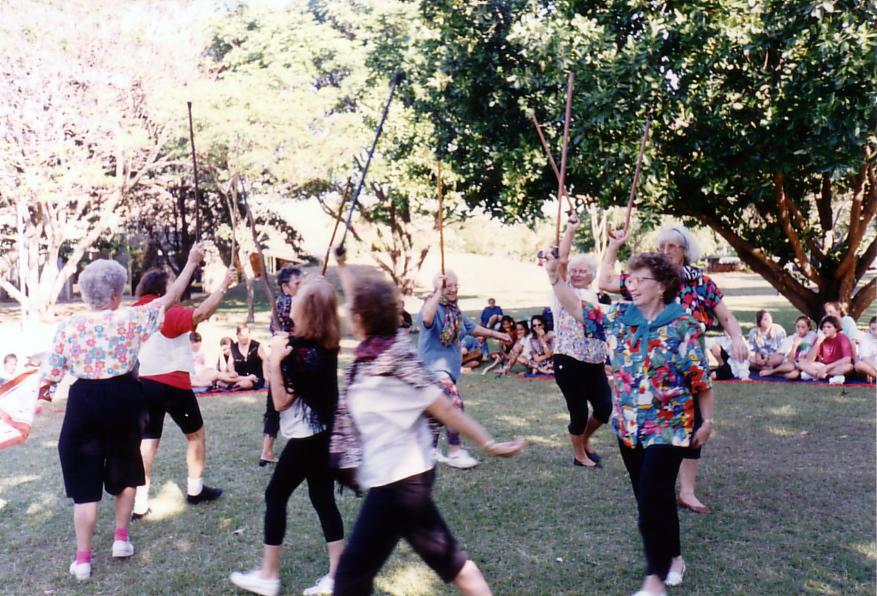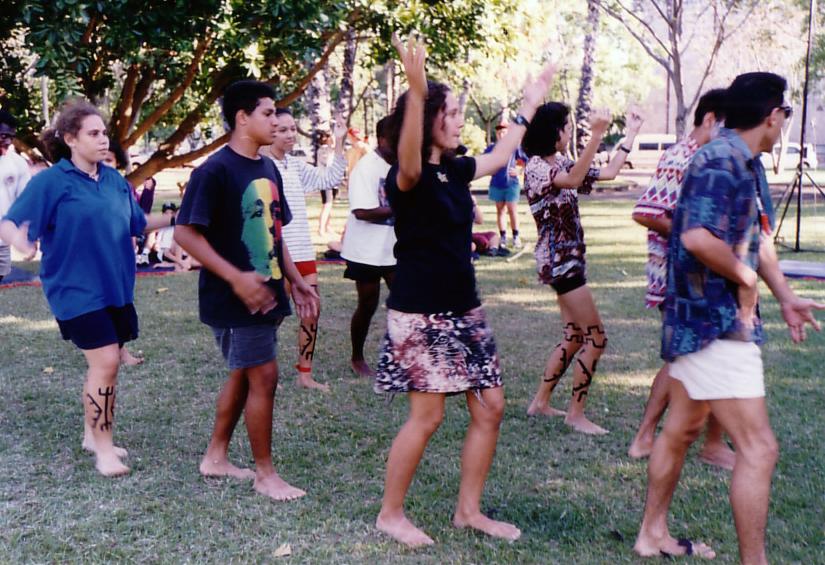Gathering Ground (2)
Text
Darwin Civic Park, Darwin City
June 11, 1994
In the year that gives birth to Tracks Dance Collective, this second Gathering Ground is part of an ongoing search into ways of working with the incredibly diverse community that exists in Darwin. Gathering Ground was a Bougainvillea Festival Fringe event that was performed on Saturday June 11th. It was a large scale Community Dance performance presented in the Civic Gardens, Darwin.
We did not charge the performers or the support people with the cultural groups for this event. Being an outdoor event it is difficult to gather entrance fees but despite the people who come late after dark and refused to pay, we still sold 115 tickets and gave out 13 complimentary; a total of 128 tickets.
This project was part of an ongoing search into ways of working with the incredibly diverse community that exists in Darwin. It is hard to satisfy the many groups and individuals without creating an extravaganza event that would go for several days.
Tracks believe that looking at ‘why’ we might come together, rather than ‘how’ we might come together, was an important decision that greatly contributed to the success of this project. It was an initial, but significant, attempt to recognise the differences we have to deal with every day. Rather than looking at a cultural form that integrates and amalgamates to an extent such that the richness of cultural expression is lost, we were searching for a joyous celebration of everyone, no matter what his or her history. The telling of diverse stories to create one larger story was far more indicative of the community than any single themed story could ever be. Gathering Ground was the creation of a contemporary community myth.
As an extension of Gathering Ground 1993 we established a theme that would bind a wide variety of groups together. Rather than find a single common thread, we arrived at an idea of a common ground, or Gathering Ground, where many groups of people could exist in the same place. Thus, each group would have to solve the problem of why their group was gathering, where they had come from, what story they wished to convey. The resulting performance would be a joining of the stories.
It was necessary to have a performance where the separate groups rehearsed in their own time and only come together for essential rehearsals, (one dress rehearsal and one technical rehearsal).
We had several groups that we were already working with and contacted several others. It was decided that the cultural groups that ended up in the performance would be paid an honorarium, in recognition that they are always asked to perform at community events but never financially remunerated for their time, travel, or actual costs.
Overall the evening was most successful. The participating groups were pleased, some of who had never performed before. No one felt out of place and all the cultural groups stayed until the end of the performance; an unusual thing as they often perform and leave because they do not really feel welcome or catered for.
TRACKS Dance Collective had learnt fire dancing for this performance. Initially we had hoped to have someone teach us but as the members of the Fire Weavers are quite transitory, there was no-one in town to teach us. We had hoped that they would also be able to pass these skills onto our Adult Dance Mob members but this did not eventuate. In the end we taught ourselves and were very happy with the results.
The students of O’Loughlin College were ecstatic. They do not have a high self-esteem and many things happening in their school community added to this. However, the simple and effective choreography by Kelly Bray, (as well as her incredible enthusiasm and drive,) made their performance incredibly dynamic.
The dance by Dorethea Randall, performed to a song written by her father and sung by Allyson Mills was also a moving part of the evening. “My Brown Skin Baby Was Taken Away”. Dorethea’s performance was an opportunity for Darwin audiences to see her own unique ‘fusion’ style of dance that incorporates both traditional Aboriginal movement with contemporary styles.
The Adult Dance Mob group had worked on words and phrases from ideas to do with “gathering” & “ground”. Their non-narrative work was additionally important as it incorporated several members of the Art Ability group who had integrated into our open workshops that term. Both Tim and William are becoming consummate performers.
Of great delight were our Grey Panthers, a group of women over 50 years old, and currently under 79. They looked at where and how they gather. The end result being a display of community attitudes to older people - the “decrepit’ dance complete with sticks, shawls, handbags and other sundry props. The dance progressed into an abstracted game of lawn bowls showing these energetic and often fiery women socialising and competing with each other. Finally they display their varied skills by letting loose with a rap dance. These women are an ongoing inspiration to other community members as they refuse to become invisible and believe that if others do not give them a chance then they will make their own opportunities.
The Corrugated Iron Youth Theatre groups (including Art Ability) showed us a movement story that looked at our degradation of the land and sea. These groups were preparing for a performance later as part of World Environment Day.
Lisa Campbell’s School of Dance utilised the burgeoning talents of the pre-primary students who took the idea of Green Ants gathering food. The discipline of these “ants” was to be admired.
The East Timorese, with their beautifully woven cloth, their powerful drumming and an exquisite emblem which was processed on at the beginning remind us of the closeness we have with them as our closest neighbours.
Kulay Lupa’s dance of lights used coconut shells as lanterns. Accompanied by Betchay Mondragon on the gong, these women added a strong sense of ceremony to the proceedings.
The final group, The Papua New Guinea dancers, Sanguma, with their vibrant drumming, fast and intricate tempos and ever-present vitality finished the proceedings with dances that the audience joined in with.
Coordinators Notes
Creative Personnel
Coordinator Choreographers: David McMicken and Sarah Calver
Choreographers: Dorethea Randall, Lisa Campbell, Berenice Franklin, Kelly Bray and Betchay Mondragon
Designer (Corrugated Iron Youth Theatre): Melody Cooper
Cultural Liaison – Lafaek: Jose Casimiro
Traditional cultural dance and music groups: Kulay Lupa, Lafaek, and Sanguma
Performers
Tracks Dance Collective
Sarah Calver, David McMicken, Lisa Campbell, Berenice Franklin, Dorethea Randall, Danielle Spruyt
O'Loughlin Catholic College
Choreographer – Kelly Bray. Adam Killop, Adrian Ryan, Allen Mu, Alyssa Marshall, Andreia Bolito, Andrew Billsborrow, Andrew Stavers, Ashleigh Williams-Hook, Caroline Webb, Celia Denhann, Conor Fox, Cyra Laurente, Dale Edwards, Danielle Francis, De-Anne McKenna, Ebony Fromm, Emma Weston, John Ciarla, John Higgins, Jolene Mooney, Jonathon King, Katrina Clark, Kelin Stevens, Lisa Nichols, Mark Fletcher, Mathew Bradley, Matthew Duggan, Melina Callicazaros, Michaelina Reynolds, Natalie Dawson, Raleigh Phillips, Sharon Gordon, Susie Clee, Tenille Cahill
Lisa Campbell School Of Dance
Pre Primary Students
Indigenous Dancers
Dorethea Randall & Allyson Arjibuk Mills
Kulay Lupa Filipino Cultural Group
Corrugated Iron Youth Theatre
Alexander Marks, Amanda Mouthasm, Amy Hudson, Anna Whitehead, Annie Cole, Ben Goodvach-Draffin, Chantal Marks, Charmain Brown, Chloe Coleman, Dale Rolfe, Elisabeth Bell, Felicity Wardle, Grae Saunders, Helen Atkinson, Imogen Studders, Jason Davies, Jessica Greatwich, Jessie Brewster, John Nolan, Kayt Douglas, Lani Studders, Leon Defrenne, Margot Hudson, Matthew Gill, Megan Burgess, Nicole Wills, Petra Linden-Ross, Rachael Lilliebridge, Rhys James, Sara Caldwell, Sundari Forward, William Joswig
Lafaek East Timorese Cultural group
Anabella Bernadino, Cesar Gusmao, Dulcie Munn, Ines Branco, Jenna Munn, Jose Casimiro, Jose Gusmao, Joshua Bernadino, Laca Bernadino, Michelle Immonen, Nina Lopes, Odette Cameirao, Rebecca Cameirao, Shana Pereira, Tara Munn, Veronica Maia
Grey Panthers - Darwin Dance Mob Older Adults (16)
Darwin Dance Mob – adults
Berenice Franklin, Danielle Spruyt, James Barnett, Kaz, Nicolene Rubin, Timm Hill, Toni, William Joswig
Sanguma Dance Company, PNG Australia Social and Cultural Group (20)
Scenario
- Group’s gather on the outskirts of the gathering ground according to where they came from, eg. Papua new Guinea from the North East, East Timorese from the North, younger children from all over.
- Each group arrives at the gathering ground in appropriate manner. Some dancing, some processing, others acting.
- All performers finish placed around the circular performance space and sit.
- TRACKS Dance Collective performs a fire dance, welcoming everyone, audience and performers alike. Central fire is lit, (fire place, camp fire, cooking fire, hearth, beacon.) Fire lanterns are lit at the four compass points, making each entrance a fire archway.
- Each group presents their dance “story”, entering from a variety of points.
- Sanguma is last and finishes with audience participation.
Tracks Dance Collective 1994
Collective Members: Sarah Calver, David McMicken, Tim Newth, Berenice Franklin, Lisa Campbell
Brown’s Mart Community Arts Dance Development Offices: Sarah Calver, David McMicken
[Under Brown's Mart Community Arts – Executive Officer Ken Conway]
Photos
Videos
Explore Further
Responses
“The weaving together of these stories has created a performance style representative of the northern environment” Northern Territory News




